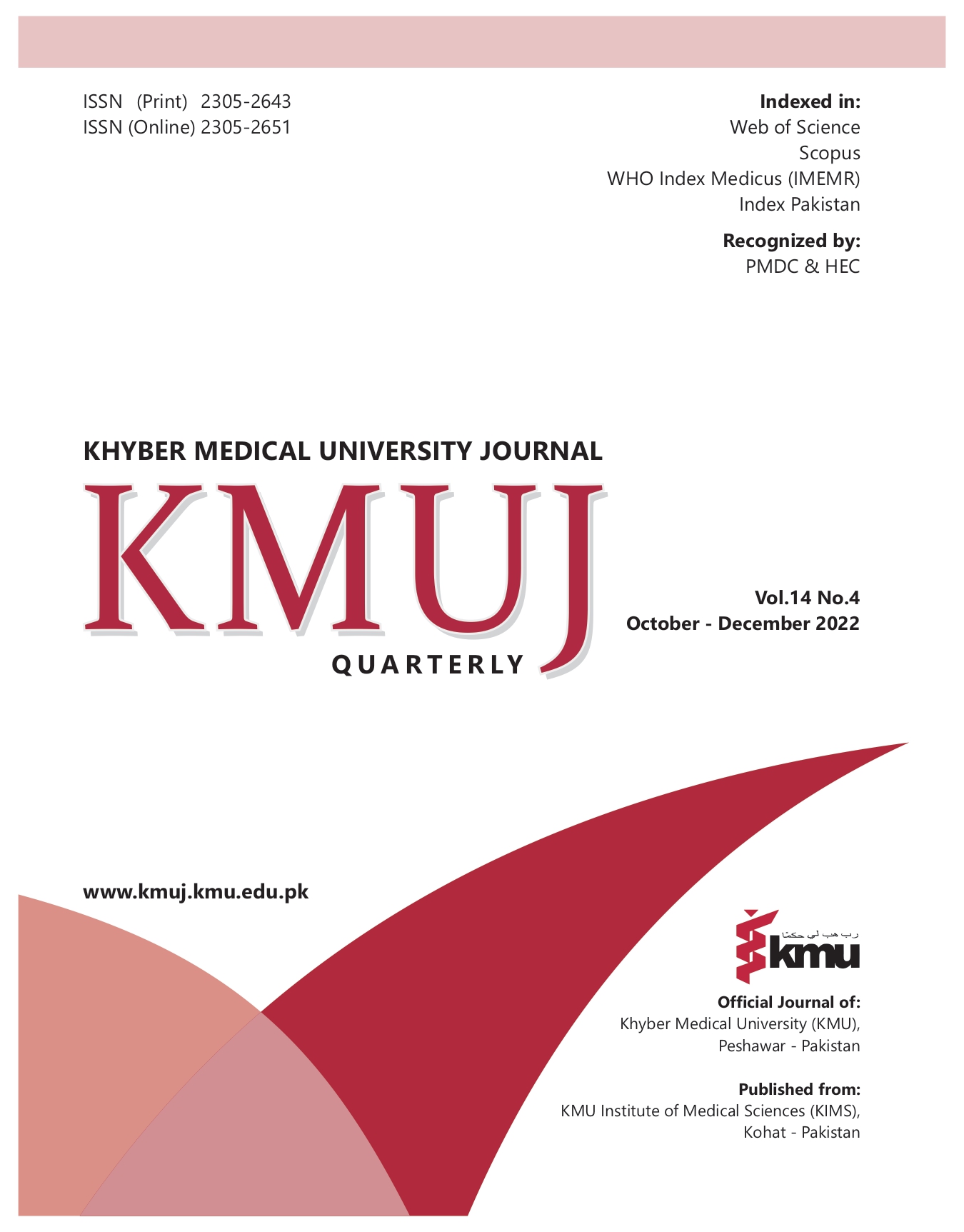DIAGNOSTIC ACCURACY OF ULTRASOUND IN EARLY DETECTION OF MOLAR PREGNANCY
Main Article Content
Abstract
OBJECTIVE: To determine the diagnostic accuracy of ultrasound in detection of molar pregnancy taking histopathological findings as a gold standard.
METHODS: This study was conducted in Khyber Teaching Hospital, Peshawar, Pakistan. All pregnant females of 15-45 years’ age; with clinical, biochemical suspicion and definite diagnosis of molar pregnancy were included in our study. Patients already diagnosed on histopathology as hydatidiform mole, missed miscarriage and invasive mole were excluded from the study. Informed consent, brief history, baseline Investigations, serum beta Human Chorionic Gonadotropin levels were obtained. Suspected cases of hydatidiform mole (n=212) on Transabdominal Ultrasound scans were referred to gynecologist for histopathological diagnosis and management. Histopathology of samples were compared to ultrasound report. Data was collected was analyzed by SPSS v.23.0.
RESULTS: Mean age of patients was 29.04±8.23 years. Molar pregnancies were reported in 119 (56.13%) and 124 (58.49%) cases through ultrasound and histopathology respectively. Ultrasound findings suggestive of complete molar pregnancy in 79 (37.2%) cases, as compared to 85 (40.09%) cases by histopathology. Majority (n=35; 58.3%) of the molar pregnancy were found in patients having 31-40 years of age. Ultrasound and histopathology showed agreement in diagnosis of molar pregnancy in 103/156 (66%) cases and non-molar pregnancy in 40/56 (71.4%) cases. Sensitivity, specificity, positive predictive value, negative predictive value and overall diagnostic accuracy of Ultrasound in diagnosis of molar pregnancy were 66.03%, 71.43%, 86.55% 43.01% and 67.45% respectively.
CONCLUSION: Overall diagnostic accuracy of ultrasound in diagnosis of molar pregnancy is 67.45% and may be used in early detection of molar pregnancy.
Article Details
Work published in KMUJ is licensed under a
Creative Commons Attribution 4.0 License
Authors are permitted and encouraged to post their work online (e.g., in institutional repositories or on their website) prior to and during the submission process, as it can lead to productive exchanges, as well as earlier and greater citation of published work.
(e.g., in institutional repositories or on their website) prior to and during the submission process, as it can lead to productive exchanges, as well as earlier and greater citation of published work.
References
Allen SD, Lim AK, Seckl MJ, Blunt DM, Mitchell AW. Radiology of gestational trophoblastic neoplasia. Clin Radiol 2006;61(4):301-13. https://doi.org/10.1016/j.crad.2005.12.003
Seckl MJ, Sebire NJ, Berkowitz RS. Gestational trophoblastic disease. Lancet 2010;376(9742):717-29. https://doi.org/10.1016/s0140-6736(10)60280-2
Lybol C, Thomas CMG, Bulten J, Van Dijck JAAM, Sweep FCGJ, Massuger LFAG. Increase in the incidence of gestational trophoblastic disease in The Netherlands. Gynecol Oncol 2011;121(2):334-8. https://doi.org/10.1016/j.ygyno.2011.01.002
Nizam K, Haider G, Memon N, Haider A. Gestational Trophoblastic Disease: Experience at Nawabshah hospital. J Ayub Med Coll 2009;21(1):94–7.
Donald I. Use of ultrasonics in diagnosis of abdominal swellings. Br Med J 1963;2(5366):1154-5. https://doi.org/10.1136/bmj.2.5366.1154
Robinson DE, Garrett WJ, Kossoff G. The diagnosis of hydatidiform mole by ultrasound. Aust N Z J Obstet Gynaecol 1968;8(2):74-8. https://doi.org/10.1111/j.1479-828x.1968.tb00686.x
Donald I, Brown TG. Demonstration of tissue interfaces within the body by ultrasonic echo sounding. Br J Radiol 1961;34:539-46. https://doi.org/10.1259/0007-1285-34-405-539
Eagles N, Sebire NJ, Short D, Savage PM, Seckle MJ, Fisher RA. Risk of recurrent molar pregnancies following complete and partial hydatidiform moles. Hum Reprod 2016;31(6):1379. https://doi.org/10.1093/humrep/dew079
Fowler DJ, Lindsay I, Seckl MJ, Sebire NJ. Routine pre-evacuation ultrasound diagnosis of hydatidiform mole: experience of more than 1000 cases from a regional referral center. Ultrasound Obstet Gynecol 2006;27(1):56-60. https://doi.org/10.1002/uog.2592
Fine C, Bundy AL, Berkowitz RS, Boswell SB, Berezin AF, Doubilet PM. Sonographic diagnosis of partial hydatidiform mole. Obstet Gynecol 1989;73(3 Pt 1):414-8.
Lazarus E, Hulka C, Siewert B, Levine D. Sonographic appearance of early complete molar pregnancies. J Ultrasound Med 1999;18(9):589-94. https://doi.org/10.7863/jum.1999.18.9.589
Shanbhogue AK, Lalwani N, Menias CO. Gestational trophoblastic disease. Radiol Clin North Am 2013;51(6):1023-34. https://doi.org/10.1016/j.rcl.2013.07.011
Sebire NJ, Rees H, Paradinas F, Seckl M, Newlands E. The diagnostic implications of routine ultrasound examination in histologically confirmed early molar pregnancies. Ultrasound Obstet Gynecol 2001;18(6):662-5. https://doi.org/10.1046/j.0960-7692.2001.00589.x
Johns J, Greenwold N, Buckley S, Jauniaux E. A prospective study of ultrasound screening for molar pregnancies in missed miscarriages. Ultrasound Obstet Gynecol 2005;25(5):493-97. https://doi.org/10.1002/uog.1888
Kirk E, Papageorghiou AT, Condous G, Bottomley C, Bourne T. The accuracy of first trimester ultrasound in the diagnosis of hydatidiform mole. Ultrasound Obstet Gynecol 2007;29(1):70-5. https://doi.org/10.1002/uog.3875
Savage JL, Maturen KE, Mowers EL, Pasque KB, Wasnik AP, Dalton VK, et al. Sonographic diagnosis of partial versus complete molar pregnancy: a reappraisal. J Clin Ultrasound 2017;45(2):72-8. https://doi.org/10.1002/jcu.22410
Sebire NJ, Foskett M, Fisher RA, Rees H, Seckl M, Newlands E. Risk of partial and complete hydatidiform molar pregnancy in relation to maternal age. Br J Obstet Gynecol 2002;109(1):99-102. https://doi.org/10.1111/j.1471-0528.2002.t01-1-01037.x
Alsibiani SA. Value of histopathologic examination of uterine products after first-trimester miscarriage. Biomed Res Int 2014;2014:863482. https://doi.org/10.1155/2014/863482
